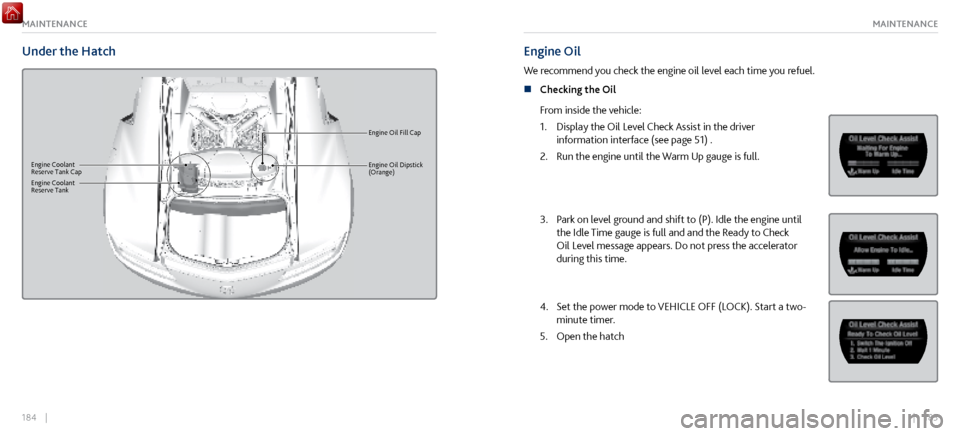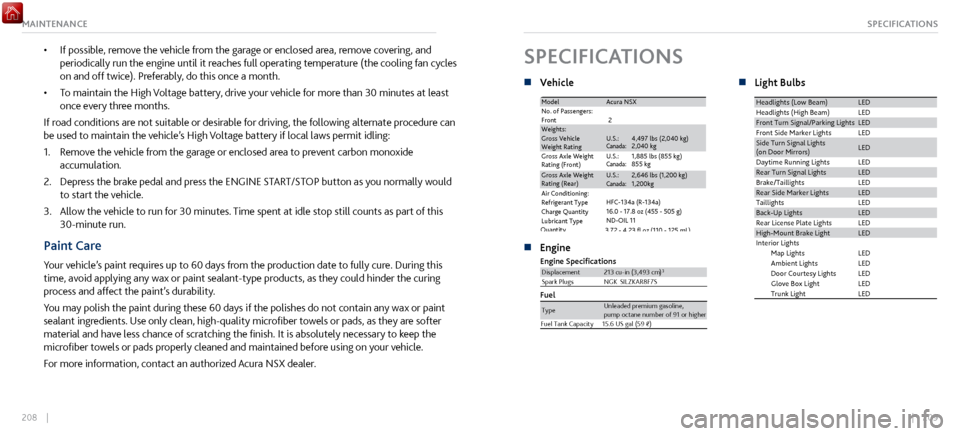fuel cap Acura NSX 2017 Owner's Guide
[x] Cancel search | Manufacturer: ACURA, Model Year: 2017, Model line: NSX, Model: Acura NSX 2017Pages: 116, PDF Size: 7.19 MB
Page 77 of 116

148 || 149
DRIVINGDRIVING
Refueling
Use the proper fuel and refueling procedure to ensure the best performance and safety of your
vehicle.
n
Fuel Information
Unleaded premium gasoline of 93 octane maximiz
es the engine’s performance.
Unleaded premium gasoline of 91 octane or higher is recommended.
Use of gasoline with octane less than 91 can lead to engine damage.
Acura recommends TOP TIER Detergent Gasoline where available.
Do NOT use gasoline containing more than 15% ethanol.
Do NOT use gasoline containing methanol.
Do NOT use gasoline containing MMT.
We recommend quality gasoline containing detergent additives that help prevent fuel
system and engine deposits. In addition, in order to maintain good performance, fuel
economy, and emissions control, we strongly recommend the use of gasoline that does NOT
contain harmful manganese-based fuel additives such as MMT, if such gasoline is available.
NOTICE n
How to Refuel
The fuel
fill door is located at the left rear of the vehicle. Park next to the service pump that
is most accessible. This vehicle does not use a fuel-fill cap.
Turn off the power system.
Press the fuel fill door release button.
Insert the filler nozzle fully. When the tank is full, the fuel
nozzle clicks off automatically.
Wait about five seconds. Remove the filler nozzle and close
the fuel fill door.
Press
Gasoline is highly flammable and explosive. You can be burned or seriously
injured when handling fuel.
Stop the engine, and keep heat, sparks, and flame away.
Handle fuel only outdoors.
Wipe up spills immediately.
WARNING
Fuel Fill Door Release Button
Page 95 of 116

184 || 185
MAINTENANCEMAINTENANCE
Under the Hatch
Engine Oil Fill Cap
Engine Coolant
Reserve Tank Cap
Reserve TankEngine Coolant
Engine Oil Dipstick
(Orange)
Engine Oil
We recommend you check the engine oil level each time you refuel.
n
Checking the Oil
From
inside the vehicle:
1.
Display the Oil Level
Check Assist in the driver
information interface (see page 51) .
2.
Run the engine until the W
arm Up gauge is full.
3. Park on level ground and shift to (P). Idle the engine until
the Idle Time gauge is full and and the Ready to Check
Oil Level message appears. Do not press the accelerator
during this time.
4. Set the power mode to VEHICLE OFF (LOCK). Start a two-
minute timer.
5.
Open the hatch
Page 98 of 116

190 || 191
MAINTENANCEMAINTENANCE
n Adding Coolant
Make sure
the engine and radiator are cool.
Turn the reserve tank cap counterclockwise and relieve any
pressure in the coolant system. Do not push the cap down
when turning.
Push down and turn the cap counterclockwise to remove it.
Pour coolant into the reserve tank until it reaches the MAX
mark. Put the cap back on the reserve tank and tighten.
Reserve Tank
Cap
Removing the reserve tank cap while the engine is hot can cause the coolant to
spray out, seriously scalding you.
Always let the engine and radiator cool down before removing the reserve tank
cap.
WARNING
Pour the fluid slowly and carefully so you do not spill any. Clean up any spills immediately;
they can damage components in the engine compartment.
NOTICE
Inverter Coolant
Check the inverter coolant level every time you refuel
n
Checking the Inverter
Coolant Level
Open the hood.
If the inverter coolant is below the MIN level, have your
vehicle serviced at an authorized Acura NSX dealer.
MA X
MIN
Filler
Tank
Window Washer Fluid
If the washer fluid is low, a message will appear on the driver information interface. Do not
overfill the reservoir.
Do not use engine antifreeze or a vinegar/water solution in the windshield washer reservoir.
Antifreeze can damage your vehicle’s paint. A vinegar/water solution can damage the windshield
washer pump.
NOTICE
Page 101 of 116

196 || 197
MAINTENANCEMAINTENANCE
4. Push to compress the wiper blade until it clears the end cap,
then pull to slide it up and out
of the holder.
Holder
5. Slide the new wiper blade into the holder and secure the end
into the cap. Slide the blade holder onto the wiper arm until
it clicks, then lower the arm.
6.
Set the power mode to ON. Hold
the wiper switch in MIST
until the wiper arms return to their normal position..Wiper Blade
the bottomEnd Cap at
Avoid dropping the wiper arm, as it may damage the windshield.
NOTICE
Tire Information
To safely operate your vehicle, your tires must be of the proper type and size, in good condition
with adequate tread, and properly inflated.
n
Inflation Guidelines
Properly inflated tir
es provide the best combination of handling, tread life, and comfort.
Refer to the driver’s doorjamb label or the specifications (see page 127) for the specified
pressure.
Underinflated tires wear unevenly, adversely affect handling and fuel economy, and are
more likely to fail from overheating.
Overinflated tires make your vehicle ride harshly, are more prone to road hazards, and wear
unevenly.
Every day before you drive, look at each of the tires. If one looks lower than the others,
check the pressure with a tire gauge.
Measure the air pressure when tires are cold. This means the vehicle has been parked for at
least 3 hours, or driven less than 1 mile (1.6 km). If necessary, add or release air until the
specified pressure is reached. If checked when hot, tire pressure can be as much as 4-6 psi
(30-40 kPa, 0.3-0.5 kgf/cm
2) higher than checked when cold.
At least once a month or before long trips, use a gauge to measure the pressure in all tires,
including the spare. Even tires in good condition can lose 1-2 psi
(10-20 kPa, 0.1-0.2 kgf/cm
2) per month.
Page 107 of 116

208 || 209
SPECIFICATIONSMAINTENANCE
• If possible, remove the vehicle from the garage or enclosed area, remove covering, and
periodically run the engine until it reaches full operating temperature (the cooling fan cycles
on and off twice). Preferably, do this once a month.
•
To maintain the High V
oltage battery, drive your vehicle for more than 30 minutes at least
once every three months.
If road conditions are not suitable or desirable for driving, the following alternate procedure can
be used to maintain the vehicle’s High Voltage battery if local laws permit idling:
1.
Remove
the vehicle from the garage or enclosed area to prevent carbon monoxide
accumulation.
2.
Depress the brake pedal and pr
ess the ENGINE START/STOP button as you normally would
to start the vehicle.
3.
Allow the vehicle
to run for 30 minutes. Time spent at idle stop still counts as part of this
30-minute run.
Paint Care
Your vehicle’s paint requires up to 60 days from the production date to fully cure. During this
time, avoid applying any wax or paint sealant-type products, as they could hinder the curing
process and affect the paint’s durability.
You may polish the paint during these 60 days if the polishes do not contain any wax or paint
sealant ingredients. Use only clean, high-quality microfiber towels or pads, as they are softer
material and have less chance of scratching the finish. It is absolutely necessary to keep the
microfiber towels or pads properly cleaned and maintained before using on your vehicle.
For more information, contact an authorized Acura NSX dealer. n
Vehicle
ModelAcura NSX
No. of Passengers :
Front 2
Weights:Gross Vehicle
Weight RatingU.S. :4,497 lbs (2,040 kg)Canada :2,040 kgGross Axle Weight
Rating (Front)U.S.:1 ,885 lbs (855 kg)Canada :855 kgGross Axle Weight
Rating (Rear)U.S.:2,646 lbs (1,200 kg)Canada :1,200kg
Air Conditioning:
Refrigerant Type
Charge Quantit y
Lubricant Type
HFC-134a (R-134a) 16.0 - 17.8 oz (455 - 505 g)
ND-OIL 11
Quantity3.72 - 4.23 � oz (110 - 125 mL)
n Engine
Fuel
Engine Specification sDisplacement 213 cu-in (3,493 cm3)
NG K
Spark PlugsSILZKAR8F7S
Unleaded premium gasoline,
Type
pump octane number of 91 or higher
Fuel Tank Capacity 15.6 US gal (59 ℓ)
n Light Bulbs
LE DLEDLEDLED
LED
LEDLEDLEDLEDLEDLEDLEDLED
LEDLEDLEDLEDLED
Map Lights
Ambient Lights
Door Courtesy Lights
Glove Box Ligh t
Trunk Light
Headlights (Low Beam )Headlights (High Beam )
Front Turn Signal/Parking Lights
Front Side Marker Lights
Side Turn Signal Lights
(on Door Mirrors)
Daytime Running Lights
Rear Turn Signal Lights
Brake/Taillights
Rear Side Marker Lights
Taillights
Back-Up Lights
Rear License Plate Lights
High-M ount Brake Ligh t
In terior Lights
SPECIFICATIONS